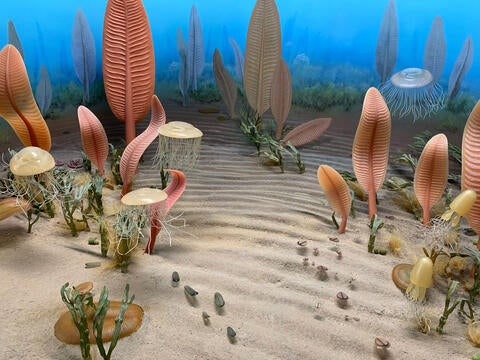5億5,000万年前の生物が現代に伝えるメッセージ 550-million-year-old creatures’ message to the present
2022-11-22 カリフォルニア大学リバーサイド校(UCR)

Diorama depicting Ediacaran-era sea creatures. (Smithsonioan Institution)
2億5200万年前のペルム紀から三畳紀にかけて、地球上の生き物の大半が姿を消したのである。
同様の絶滅が5億5千万年前のエディアカラ紀に起こったことが明らかになった。
研究者らは、地球上で最初の複雑な多細胞生物であったエディアカラ生物全体の約80%が失われたのは、環境の変化が原因であるとみている。
地質学的記録は、その時期に世界の海が大量の酸素を失い、生き残った少数の種が低酸素環境に適応した体を持っていたことを示している。
この最古のイベントは、その後のイベントとは異なり、滅んだ生物が柔らかい体をしており、化石記録にうまく保存されなかったため、記録するのがより困難であった。
研究チームは、ほぼすべての既知のエディアカラ動物の環境、体の大きさ、食事、移動能力、習性を記録した。
研究者らは、生物の体積に対する表面積の比率を追跡しました。これは、酸素レベルの低下が死滅の原因であることを示唆している。
<関連情報>
- https://news.ucr.edu/articles/2022/11/22/earth-might-be-experiencing-7th-mass-extinction-not-6th
- https://www.pnas.org/doi/10.1073/pnas.2207475119
エディアカラ紀白海-ナマ移行期における最初の大規模動物絶滅の環境的要因 Environmental drivers of the first major animal extinction across the Ediacaran White Sea-Nama transition
Scott D. Evans, Chenyi Tu, Adriana Rizzo, Rachel L. Surprenant, Phillip C. Boan, Heather McCandless, Nathan Marshall, Shuhai Xiao and Mary L. Drose
Proceedings of the National Academy of Sciences Published:November 7, 2022
DOI:https://doi.org/10.1073/pnas.2207475119
Significance
Mass extinctions are well recognized as significant steps in the evolutionary trajectory of life on this planet. Here, we document the oldest known extinction of animals and test for potential causes. Our results indicate that, like younger diversity crises, this event was caused by major shifts in environmental conditions. Particularly, we find support for decreased global oxygen availability as the mechanism responsible for this extinction. This suggests that abiotic controls have had significant impacts on diversity patterns throughout the more than 570-My history of animals on this planet.
Abstract
The Ediacara Biota—the oldest communities of complex, macroscopic fossils—consists of three temporally distinct assemblages: the Avalon (ca. 575–560 Ma), White Sea (ca. 560–550 Ma), and Nama (ca. 550–539 Ma). Generic diversity varies among assemblages, with a notable decline at the transition from White Sea to Nama. Preservation and sampling biases, biotic replacement, and environmental perturbation have been proposed as potential mechanisms for this drop in diversity. Here, we compile a global database of the Ediacara Biota, specifically targeting taphonomic and paleoecological characters, to test these hypotheses. Major ecological shifts in feeding mode, life habit, and tiering level accompany an increase in generic richness between the Avalon and White Sea assemblages. We find that ∼80% of White Sea taxa are absent from the Nama interval, comparable to loss during Phanerozoic mass extinctions. The paleolatitudes, depositional environments, and preservational modes that characterize the White Sea assemblage are well represented in the Nama, indicating that this decline is not the result of sampling bias. Counter to expectations of the biotic replacement model, there are minimal ecological differences between these two assemblages. However, taxa that disappear exhibit a variety of morphological and behavioral characters consistent with an environmentally driven extinction event. The preferential survival of taxa with high surface area relative to volume may suggest that this was related to reduced global oceanic oxygen availability. Thus, our data support a link between Ediacaran biotic turnover and environmental change, similar to other major mass extinctions in the geologic record.


